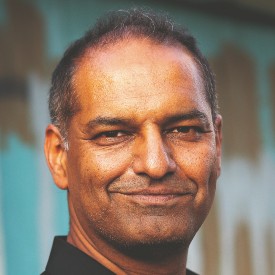Dr. Charan Ranganath is Professor of Neuroscience and Psychology and Director of the Memory and Plasticity Program at the University of California, Davis. He has been studying the neuroscience of memory for over 25 years.
Below, Charan shares five key insights from his new book, Why We Remember: Unlocking Memory’s Power to Hold on to What Matters. Listen to the audio version—read by Charan himself—in the Next Big Idea App.

1. Memory is not about the past; it’s about the present and future.
Whenever I tell people that I study memory, one of the most common responses I get is, “Maybe you can study me—my memory is terrible.” And sure, I get it, whether it’s being unable to recall someone’s name, trying to find where you put your keys, or even losing track of what you were talking about a few minutes ago, forgetting sucks. But let’s face it: we all forget, and if there is one thing that memory research has shown, it is that most of our experiences are doomed to be forgotten. And that’s OK because our most typical complaints and worries about everyday forgetting are driven mainly by deeply rooted misconceptions about what memory is for in the first place.
Contrary to popular belief, the neural mechanisms of memory were not cobbled together to remember the name of the guy we met at that thing. Memory is the process by which our brains extract what’s important—that is, information that helps us make sense of an uncertain and ever-changing world. We use memory to reason, plan, and imagine, to communicate and connect, to forge our identities, and to ground ourselves in time and space.
When we look at memory as a resource to pull from, as opposed to a comprehensive archive of the past, we can make mindful choices in the present to curate a rich set of memories to take with us into the future.
2. Memories are dynamic.
When we recall a memory, we don’t replay the past; we imagine how the past could have been. This means that our recollections are shaped by our beliefs, goals, and perspectives, much like a painting reflects an artist’s unique perspective on their subject. Whenever we reconstruct these memories, the brain tinkers with them, strengthening, weakening, or modifying different aspects of the memory from the moment it is pulled up. The constructive and malleable nature of memory means that we can often remember events incorrectly, sometimes leading to colossal errors, such as when news anchor Brian Williams mistakenly recalled being in a helicopter that was shot down in Iraq.
“The constructive and malleable nature of memory means that we can often remember events incorrectly.”
Our brains are susceptible to distorted memories by design. The world around us is constantly changing, so we need to update our memories to reflect these changes. If you catch someone you thought was trustworthy in a lie or got food poisoning after a tasty dinner at a new sushi restaurant, you’d want to adjust your recollections based on that new information.
Many of us have experienced traumas or experiences that are laced with unpleasant feelings. Having a brain that has evolved to revise these memories means we can reframe how we feel about them by incorporating a new perspective. In doing so, we can update painful memories so that they can be experienced more tolerably, providing us with valuable lessons for the future.
3. Embrace the struggle.
Our computational models suggest that the brain is wired to learn from mistakes and challenges, a phenomenon called error-driven learning. This simple principle can explain the conditions under which we learn best and retain what we have learned over the long haul.
Every time we recall a memory, that memory can be updated. That’s where error-driven learning comes in. We think that attempting to recall a memory is like a stress test. If your brain struggles to do it, then once you get the answer, the brain can repair the coalition of neurons that are responsible for pulling up that memory so that next time, it can come up more easily.
Error-driven learning explains the benefits that come when we actively learn by doing rather than passively learn by memorizing. It helps explain why students benefit more from practice tests than simply studying. This is one of the reasons why students are generally better at retaining information after they have been tested on the material rather than if they only studied it.
“Error-driven learning explains the benefits that come when we actively learn by doing rather than passively learn by memorizing.”
The implications of error-driven learning are potentially huge. When a student finds coursework challenging, we tend to think that the student isn’t smart or that they are performing poorly. But the reality is that you can learn the most when you are being challenged. But to get the lasting benefits of error-driven learning, you will not always be successful. So, we should normalize mistakes and failures in education and incentivize constant improvement instead of only rewarding success. Rather than emphasizing mastery, we should celebrate the struggle of working to learn, rather than proving that you have learned something.
4. Flex and protect your prefrontal cortex.
We tend to focus on our shortcomings when it comes to memory, but for the most part, we do a pretty good job of remembering what we need to thanks to the prefrontal cortex, an evolutionary newcomer that takes up about a third of the real estate in the primate brain.
The prefrontal cortex is often described as a “central executive,” meaning that it coordinates activity across different neural networks in the service of a goal, which is also why it plays a starring role in many of our day-to-day memory successes and failures.
- First, it allows filtering out distractions so that we can create rich and detailed memories that stand out from the clutter of mundane experiences.
- Second, the prefrontal cortex allows us to mobilize strategies for learning efficiently, like the kinds of strategies that memory athlete Yanjaa Wintersoul used to memorize the entire IKEA catalog in one week.
- Third, the prefrontal cortex gives you the mental resources to think critically when you remember so that your recollections do not become distorted.
- Finally, the prefrontal cortex allows deployment of memories in real-time to anticipate what is about to happen next. The ultimate example of this is NBA legend LeBron James, who uses his exceptionally detailed memory of past basketball games to rapidly read what’s playing out on the court and make predictions in real-time.
Unfortunately, the prefrontal cortex is one of the first regions to decline as we age, and we make things worse when we multitask, are stressed out, or do not sleep enough. Frontal function is also affected by physical health conditions like diabetes and possibly long COVID and by mental health conditions like depression and PTSD. Fortunately, we can improve frontal function through physical exercise, mindfulness practices, eliminating environmental distractions (like text and email alerts), and compensating for sensory problems by using hearing aids.
5. Diversify your brain’s training data.
The most advanced artificial intelligence (AI) products acquire knowledge by plowing through massive amounts of human-generated training data. Humans, in contrast, get “training data” from lived experiences as we go to different places and interact with different people. Episodic memory (the ability to travel back in time to past events) allows us to use our unique experiences to update our knowledge and flexibly adapt to new situations rapidly.
We can get the most from episodic memory by diversifying our training data. If we change scenery from time to time and expose ourselves to people from diverse backgrounds and perspectives, we can form richer, more distinctive episodic memories.
“In the age of generative AI, we can expect that a premium will be placed on idiosyncratic human creativity and innovation.”
Conversely, when we spend too much time interacting with the same people, in the same places and situations, we have impoverished memories. For instance, during the pandemic lockdowns, as we spent each day sitting in the same room, interacting with the same people (mostly over screens), the days seemed to go on forever, and yet by the end of the week, we were left with few memories of what we did during that time.
In the age of generative AI, we can expect that a premium will be placed on idiosyncratic human creativity and innovation, which in turn benefits from seeking social interactions and media from diverse sources. A new work of art, music, or literature doesn’t arise out of thin air—it emerges from the process of integrating elements from different past experiences. By exposing ourselves to a diverse range of people and ideas, we can discover connections and recombine episodic memories into imaginative constructions that transcend the sum of their parts.
What makes human imagination special is that it offers a version of reality marked by the idiosyncrasies of its creator, rather than a perfect recording. The same can be said of memory because our memories reflect both what we experienced and our interpretations of what happened.
To listen to the audio version read by author Charan Ranganath, download the Next Big Idea App today:
































